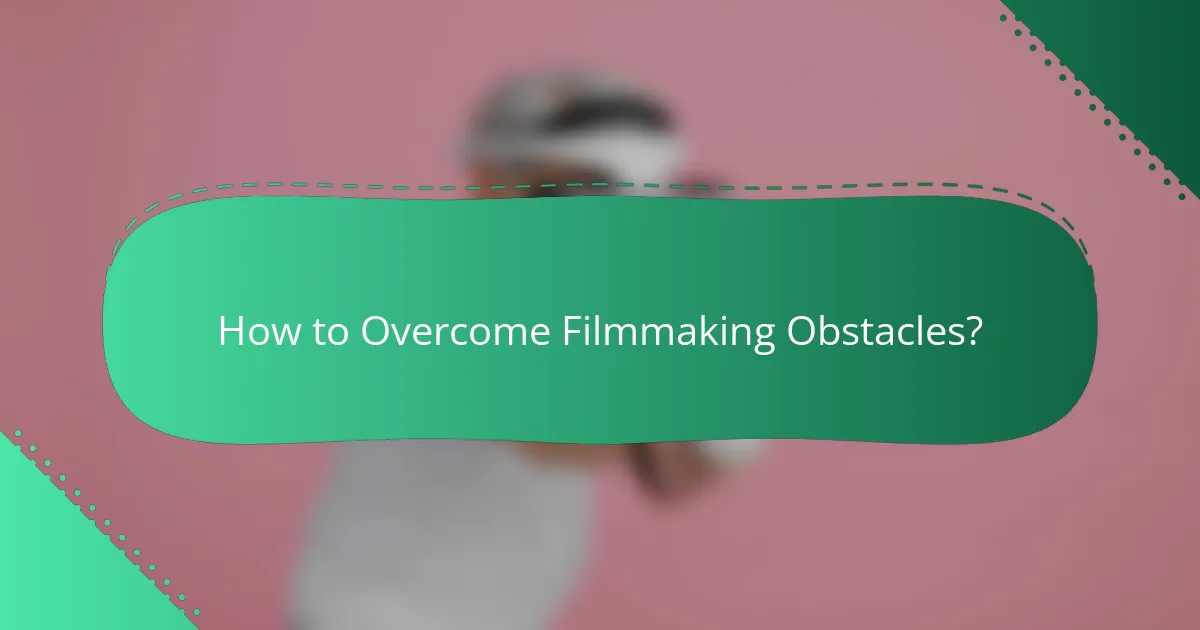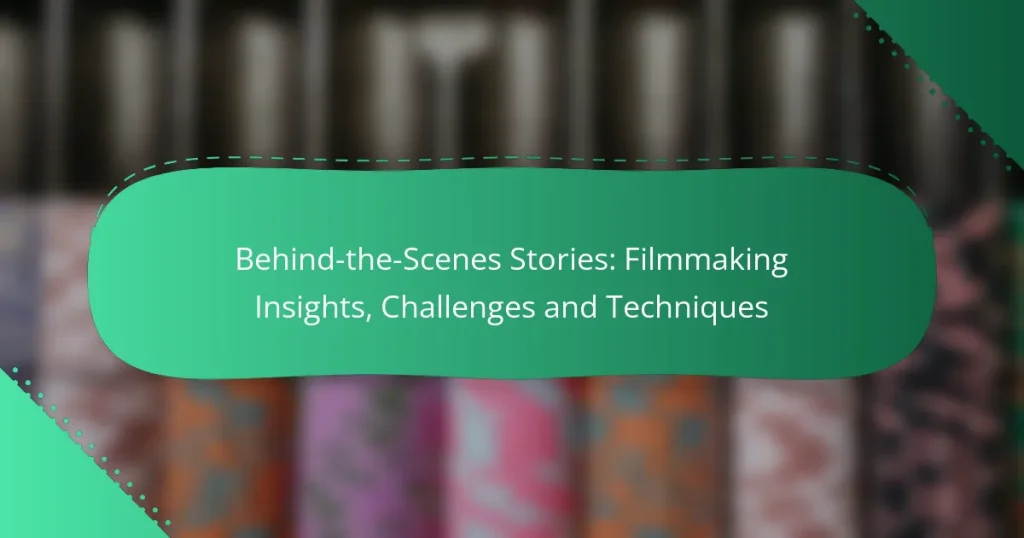Behind-the-scenes stories in filmmaking reveal the intricate techniques and challenges that shape the art of visual storytelling. From mastering cinematography and sound design to overcoming budget constraints and creative differences, filmmakers must navigate a complex landscape to bring their visions to life. Understanding these elements not only enhances the production process but also enriches the viewer’s appreciation of the final film.

What Are the Key Filmmaking Techniques?
Key filmmaking techniques encompass various methods used to create compelling visual narratives. These techniques include cinematography, sound design, editing, lighting, and directing, each playing a crucial role in shaping the final product.
Cinematography Basics
Cinematography involves capturing the visual elements of a film through camera work, framing, and movement. Key considerations include shot composition, camera angles, and the use of lenses to achieve desired effects. For instance, a wide-angle lens can create a sense of space, while a close-up can evoke intimacy.
When planning cinematography, consider the mood and tone of each scene. Utilize techniques such as depth of field to draw attention to subjects or employ tracking shots to follow action smoothly. Always keep the story’s visual style in mind to maintain coherence throughout the film.
Sound Design Essentials
Sound design is crucial for enhancing the emotional impact of a film. It includes dialogue, sound effects, and music, all of which contribute to the overall atmosphere. Effective sound design can immerse viewers in the film’s world, making it feel more authentic.
When working on sound design, pay attention to the balance between dialogue and background sounds. Use ambient sounds to create a sense of place, and consider how music can underscore emotional moments. Avoid overwhelming the audience with excessive noise; clarity is key.
Editing Techniques
Editing shapes the narrative flow and pacing of a film. It involves selecting and arranging shots to create a coherent story. Key techniques include continuity editing, which maintains a seamless flow, and montage, which can convey time or emotion quickly.
When editing, focus on maintaining rhythm and ensuring that transitions between scenes feel natural. Use cuts strategically to enhance tension or surprise. A common pitfall is over-editing; sometimes, allowing a shot to linger can have a more powerful impact.
Lighting Strategies
Lighting is essential for setting the mood and highlighting key elements in a scene. Different lighting setups, such as three-point lighting, can create depth and dimension. Soft lighting can evoke warmth, while harsh lighting can create tension or unease.
Consider the color temperature of your lights, as this affects the overall tone of the film. Use practical lights, such as lamps or candles, to enhance realism. Always test lighting setups to ensure they complement the cinematography and support the story’s emotional beats.
Directing Approaches
Directing involves guiding the overall vision of the film, including performances, pacing, and visual style. A director must communicate effectively with actors and crew to bring the script to life. Different directors may adopt various styles, from collaborative to authoritative.
When directing, focus on building trust with actors to elicit authentic performances. Be clear about your vision, but remain open to creative input. A common mistake is micromanaging; allow space for actors to explore their characters while maintaining the film’s direction.

What Challenges Do Filmmakers Face?
Filmmakers encounter various challenges that can significantly impact the production process, including budget constraints, time management issues, creative differences, and technical failures. Understanding these obstacles is crucial for navigating the complexities of filmmaking effectively.
Budget Constraints
Budget constraints are a primary challenge in filmmaking, often dictating the scale and scope of a project. Filmmakers must allocate funds wisely across various departments such as casting, locations, and post-production to ensure the project stays within financial limits.
To manage budget constraints effectively, prioritize essential elements and consider cost-saving measures like using local talent or shooting in less expensive locations. It’s also beneficial to build a contingency fund, typically around 10-15% of the total budget, to address unforeseen expenses.
Time Management Issues
Time management issues can derail a film’s production schedule, leading to rushed work and compromised quality. Filmmakers must create a detailed shooting schedule and adhere to it closely, allowing for flexibility to accommodate unexpected delays.
To improve time management, utilize tools like Gantt charts or scheduling software to track progress. Regular check-ins with the crew can help identify potential bottlenecks early, ensuring that the project remains on track.
Creative Differences
Creative differences among team members can lead to conflicts that hinder the filmmaking process. Directors, producers, and writers may have varying visions for the project, which can create tension if not addressed constructively.
To mitigate creative differences, establish clear communication channels and encourage open discussions about ideas and concerns. Regular brainstorming sessions can foster collaboration and ensure that everyone feels heard, ultimately leading to a more cohesive final product.
Technical Failures
Technical failures, such as equipment malfunctions or software crashes, can disrupt filming and lead to costly delays. Filmmakers must be prepared for these issues by conducting thorough equipment checks and having backup systems in place.
Implementing a checklist for equipment readiness and ensuring that crew members are trained to troubleshoot common problems can minimize the impact of technical failures. Additionally, consider investing in insurance to cover potential losses due to equipment failure during production.

How to Overcome Filmmaking Obstacles?
To overcome filmmaking obstacles, it’s essential to identify potential challenges early and develop strategic solutions. By focusing on effective budgeting, time management, and collaboration, filmmakers can navigate common issues and enhance their production process.
Effective Budgeting Strategies
Effective budgeting is crucial for successful filmmaking. Start by estimating costs for each production phase, including pre-production, shooting, and post-production. Allocate funds for unexpected expenses, typically around 10-15% of your total budget, to avoid financial strain.
Consider using budgeting software or templates to track expenses and adjust allocations as needed. Regularly review your budget against actual spending to identify areas for improvement and ensure financial discipline throughout the project.
Time Management Tools
Time management is vital in filmmaking to meet deadlines and maintain a smooth workflow. Utilize project management tools like Trello or Asana to organize tasks, assign responsibilities, and set timelines. These platforms help keep everyone on the same page and accountable.
Implement a production schedule that outlines key milestones and daily tasks. Regularly update the schedule based on progress and challenges, allowing for flexibility while keeping the project on track.
Collaboration Techniques
Collaboration among team members is essential for overcoming filmmaking obstacles. Foster open communication through regular meetings and feedback sessions, ensuring everyone feels valued and heard. This approach enhances creativity and problem-solving.
Utilize collaborative tools like Slack or Zoom for real-time discussions and file sharing. Establish clear roles and responsibilities to streamline decision-making and reduce confusion, leading to a more efficient production process.

What Are the Best Filmmaking Tools?
The best filmmaking tools encompass a range of equipment and software that enhance the production process. Key tools include cameras, editing software, and sound equipment, each playing a vital role in creating high-quality films.
Cameras for Independent Filmmakers
Independent filmmakers often seek cameras that balance quality and affordability. Popular choices include mirrorless cameras like the Sony A7 series and DSLRs such as the Canon EOS series, which offer excellent video capabilities without breaking the bank.
Consider factors like sensor size, lens compatibility, and low-light performance when selecting a camera. A budget of around $1,000 to $3,000 can secure a capable setup, especially when paired with good lenses.
Editing Software Comparisons
Choosing the right editing software is crucial for post-production. Adobe Premiere Pro and Final Cut Pro X are industry standards, offering robust features for both beginners and professionals. DaVinci Resolve is a strong contender, especially for color grading, and is available for free with a paid version for advanced features.
When comparing software, consider user interface, compatibility with your operating system, and the learning curve. Subscription models like Adobe’s can add up, so weigh the costs against your budget and needs.
Sound Equipment Recommendations
Quality sound equipment is essential for capturing clear audio. A good shotgun microphone, such as the Rode NTG series, can significantly improve dialogue clarity. For broader sound capture, consider lavalier mics or portable recorders like the Zoom H5.
Investing in sound equipment typically ranges from a few hundred to over a thousand dollars, depending on the quality and brand. Always test your gear before filming to avoid common pitfalls like background noise or poor connectivity.

How to Develop a Filmmaking Workflow?
Developing a filmmaking workflow involves creating a structured process that guides a project from initial concept to final edit. This workflow helps streamline production, ensuring that each phase is efficiently executed and aligned with the overall vision.
Pre-Production Planning Steps
Pre-production is crucial for setting the foundation of a film project. Key steps include script development, budgeting, casting, location scouting, and scheduling. Each element should be meticulously planned to avoid complications during filming.
Consider creating a checklist that includes essential tasks such as securing permits, finalizing contracts, and arranging equipment rentals. This will help ensure that nothing is overlooked and that the project stays on track.
Shooting Schedule Creation
Creating a shooting schedule is vital for managing time and resources effectively. This schedule should outline daily shooting goals, locations, and cast availability. It’s beneficial to allocate buffer time for unforeseen delays, which are common in film production.
Utilize tools like call sheets to communicate daily plans to the crew and cast. A well-structured schedule can significantly reduce stress and enhance productivity on set.
Post-Production Process
The post-production phase involves editing, sound design, visual effects, and color grading. Each of these elements contributes to the final product and requires careful attention to detail. It’s essential to allow adequate time for revisions and feedback during this stage.
Consider using project management software to track progress and deadlines. This can help maintain organization and ensure that all aspects of post-production are completed efficiently, leading to a polished final film.


